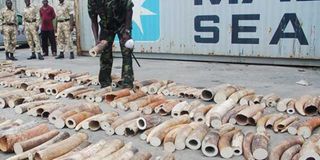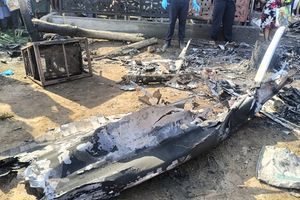Poaching fueled by corruption: Study

Kenya Wildlife Service Assistant director in charge of Coast region Mr Arthur Tuda displays to the press ivory seized at the Mombasa Port on October 8, 2013. PHOTO/FILE
What you need to know:
- Kenya lost 59 rhinos and 302 elephants in 2013
- Elephant poaching crisis has reached historic levels and shockingly, some elephant populations face extinction
A global wildlife protection lobby group has accused Kenya and other African countries of condoning corruption within its ranks leading to the raging poaching menace.
Born Free USA’s newly commissioned study claimed that corrupt government officials allowed militia from criminal networks to use locally sourced weapons in killing elephants and rhinos for their highly priced tusks and horns said to be sold in the underworld Sh86 billion market.
The organisation’s chief executive officer Adam Roberts Tuesday called for renewed global efforts to address poaching.
He called for banning of known markets and governments pressurised to fire corrupt officials who provide poachers and game trophy dealers with a conducive environment to operate.
“The elephant poaching crisis has reached historic levels and shockingly, some elephant populations face extinction in my lifetime,” he said.
The report dubbed “Ivory’s Curse: The Militarization and Professionalization of Poaching in Africa” says that poachers in Kenya enjoy 'official’ protection where they are provided with weapons to kill elephants with Mombasa’s Kilindini port being the main transit point.
The report prepared by C4ADS, a non-profit organization dedicated reporting of conflict and security issues worldwide, calls for political goodwill from world leaders where all security apparatus are fully engaged in the anti-poaching war to stop poaching across Africa.
The report asserts that organised crime, government corruption and militia are linked to elephant poaching and ivory trade.
In an earlier interview, Wildlife and Forestry Cabinet Minister Professor Judy Wakhungu reiterated the government’s commitment to wiping out poachers with the Kenya Wildlife Service boss William Kiprono saying there were no sacred cows in the anti-poaching war.
The two senior government officials said there was political goodwill in the anti-poaching war as evidenced by new laws that introduced stiff penalties on anyone dealing with game trophies.
Since the beginning of the year, 51 elephants and 11 rhinos have been killed. There is a notable increase in rhino poaching at Lake Nakuru National park where six rhinos have been killed by poachers armed with high-calibre rifles.
Kenya lost 59 rhinos and 302 elephants in 2013 compared to 2012 whereby 384 elephants and 30 rhinos were killed for their valuable tusks and horns.
C4ADS Senior Analyst Varun Vira said: “Ivory is a conflict, crime, and corruption issue with severe human impact. It has been a conflict resource for decades, just like blood diamonds or coltan in Central Africa, only without the same level of global attention."
“From Sudan, government-allied militias complicit in the Darfur genocide fund their operations by poaching elephants hundreds of miles outside North Sudan’s borders while in the Democratic Republic of Congo, state security forces patronize the very rebels they are supposed to fight, providing them with weapons and support in exchange for ivory,” the report states.
In Zimbabwe, it says political elites, including those under international sanction are seizing wildlife spaces that either are or likely will soon be used as covers for poaching operations.
Kenya, Zimbabwe, Mozambique, Tanzania and Sudan are the hardest hit according to the study that added: “where poachers move across borders with near impunity, slaughter elephants with complete disregard and use the ivory to fund violent operations across the continent. Global leaders cannot stand by while the human tragedy and poaching crisis continue.”
In Mozambique, the report says, organised crime has been militarised and consolidated to an that it has dared to cross over into South Africa in search of the precious rhino horns without fear of the well-endowed army and well-trained rangers while In Gabon and the Republic of Congo, ill-regulated forest exploitation is bringing East Asian migrant labourers into contact with Central Africa’s last elephants.
The report also accused the Tanzania’s political elites of aiding the industrial-scale depletion of East Africa’s largest elephant population.
“Subsistence elephant poaching barely exists anymore since impoverished locals may pull the triggers but they have resulted to organized crime, which controls the scale of the poaching and nearly all profits. Saving both elephants and local communities will require moving from the bush into the world of global illicit networks in order to target transnational criminal profits,” says Vira who adding that there were more young people willing to risk their lives to kill elephants for a shilling.
One elephant yields about 20 pounds of ivory worth approximately Sh2.58 million($30,000).
The handsome returns received by poachers could fuel poaching as scarcity of ivory and rhino horns will likely increase with the escalating retail price of ivory.





